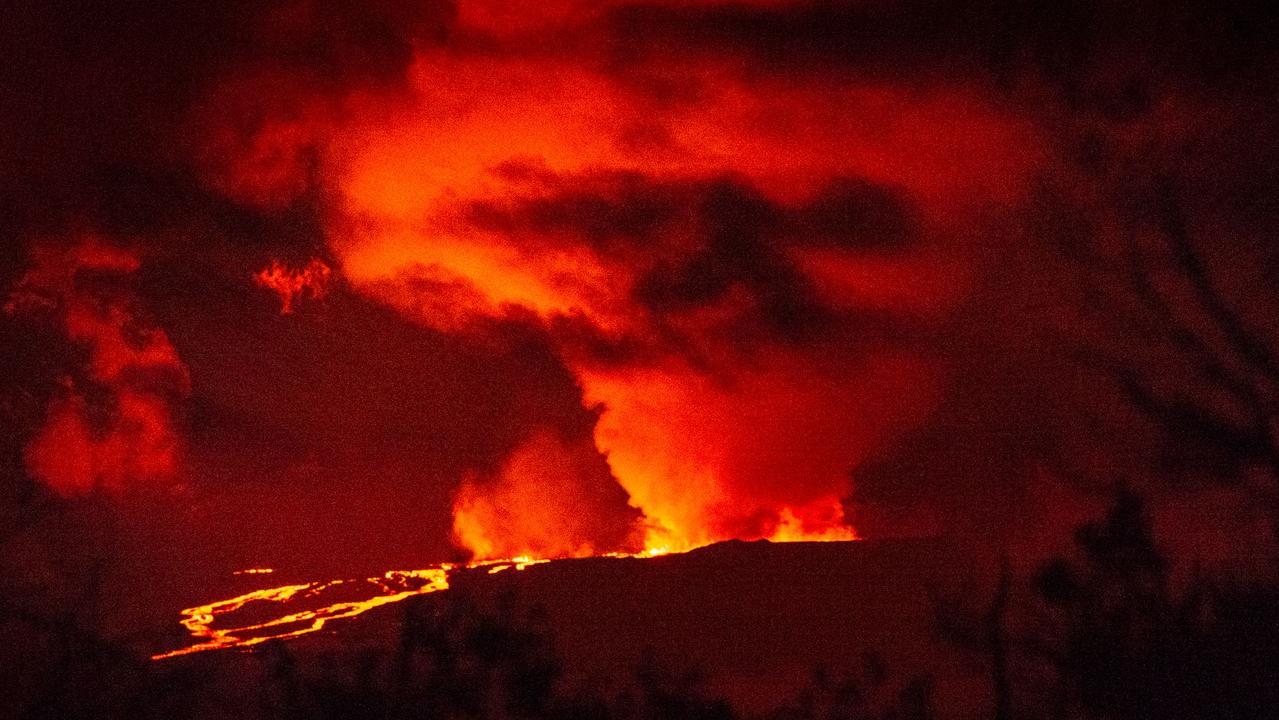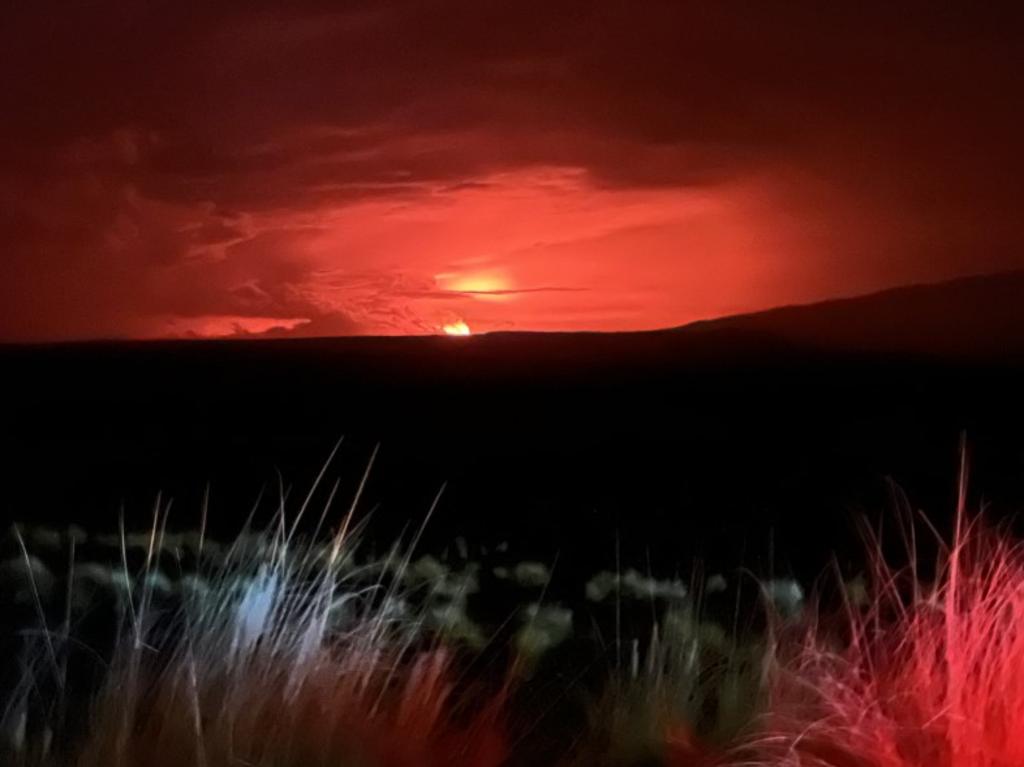World’s largest active volcano Mauna Loa erupts on Big Island
Ash and volcanic debris have transformed the sky above Hawaii as the Mauna Loa volcano erupts for the first time in 38 years and authorities advise locals to prepare for possible evacuation

READING LEVEL: ORANGE
The world’s largest active volcano, Hawaii’s Mauna Loa, is sending ash and volcanic debris* into the sky.
Mauna Loa, located on the Big Island of Hawaii, erupted for the first time in nearly 40 years late on Sunday night local time.

Although lava is now flowing down one side of the volcano, the eruption in the Hawaii Volcanoes National Park is not threatening communities, according to the US Geological* Survey (USGS), a government science agency.
“All indications are that the eruption will remain in the Northeast Rift Zone*,” the agency said in an advisory, referring to an area where the volcano is splitting, allowing for lava flow. “Volcanic gas and possibly fine ash and Pele’s Hair (strands of lava glass) may be carried downwind.”

However, the agency has warned local residents to be prepared to evacuate*.
The volcano last erupted in 1984 but scientists have been monitoring an increasing number of earthquakes at the summit.
Satellites operated by the National Oceanographic* and Atmospheric Administration (NOAA) captured the extraordinary eruption, with one animated image recording its thermal signature* and a large plume of gas spreading to the northeast of Hawaii on Sunday.

Mauna Loa rises 4169m above sea level and is a much larger volcano than the Kilauea volcano, also on the Big Island, which erupted in 2018 and destroyed 700 homes on Hawaii.
Local authorities are concerned that if Mauna Loa fully erupts, the lava flow will be much faster due to the steeper inclines of the volcano.
Local authorities have upgraded the advisory from “alert” to “RED/WARNING.”
“Winds may carry volcanic gas and possibly fine ash (downwind),” the advisory stated.
“Residents at risk from Mauna Loa lava flows should review preparedness and refer to Hawaii County Civil Defense information for further guidance.”

The early stages of a Mauna Loa eruption can be unpredictable and the advisory said the location and progress of lava flows could change quickly.
“If the eruption remains in (the bowl-like summit of the volcano), lava flows will most likely be confined within the caldera* walls,” it stated. “However, if the eruptive vents* migrate* outside its walls, lava flows may move rapidly downslope.”
The agency said it would be “monitoring the volcano closely to provide further updates on activity. As soon as possible, HVO (the Hawaiian Volcano Observatory*) will conduct aerial reconnaissance* to better describe the eruption and assess hazards.”

Mauna Loa has been showing signs of building to an eruption for years, according to the USGS, which said the ongoing eruption was visible from Kona, a town on the west coast of Hawaii’s main island some 72km from the volcano.
Scientist and volcanologist Dr Robin George Andrews said a larger threat would be if magma* began to seep from so-called rift zones along the volcano’s sides.

While there is no evidence yet of this seepage occurring on Mauna Loa, “the fact that it is a hazardous* mountain that hasn’t erupted since 1984 — the longest eruptive pause in its recorded history — is why we should all keep an eye on it,” Dr Andrews said on Twitter.
An ashfall advisory has been issued for downwind of the volcano, with a light build up of ash expected on ships in ocean waters along the Big Island’s southeast.
A USGS webcam on the summit’s north rim showed long bright eruptive crevices* within the volcanic crater, dramatically contrasted against the dark of night.

The largest volcano on Earth by volume, Mauna Loa, whose name means “Long Mountain,” covers half of the Big Island and is larger than the rest of the Hawaiian Islands combined.
One of six active volcanoes on the Hawaiian Islands, Mauna Loa has erupted 33 times since 1843, according to USGS.
The 1984 eruption lasted 22 days and produced lava flows which reached to within about seven km of Hilo, a city to the northeast which is home to about 44,000 people today.
Kilauea, a volcano on the southeastern side of Mauna Loa, erupted almost continuously between 1983 and 2019, and a current minor eruption there has been ongoing for months.
— with AFP
GLOSSARY
- debris: pieces, remains or pieces from an explosion or the destruction of something larger
- geological: related to the science of the dynamics and physical history of Earth
- rift zone: area where the volcano is rifting or splitting apart
- evacuate: to move people from a dangerous place to somewhere safe
- oceanographic: related to the science of the ocean, including chemistry, geology, meteorology and biology
- thermal signature: heat signature, infra-red energy emitted by an object, visual image of the exterior temperature of an object or person
- caldera: large, circular hollow left when the central part of a volcano falls in after an eruption
- vents: small openings that allows air, smoke, or gas to enter or leave a closed space
- migrate: move, relocate, drift, redirect, transfer
- observatory: building from which scientists watch the planets, stars and weather
- reconnaissance: exploration, observation, survey
- magma: extremely hot liquid rock found just below the surface of the Earth
- hazardous: dangerous, risky, unsafe
- crevices: openings, cracks, fissures
EXTRA READING
Boom time: hot facts about volcanoes
Towering ice volcanoes found on Pluto
Lava flow makes Spanish island bigger
Erupting volcano becomes tourist attraction
QUICK QUIZ
- Mauna Loa is located on which of Hawaii’s islands?
- How many years has it been since it last erupted?
- How far does Mauna Loa rise above sea level?
- How many times has the volcano erupted since 1843?
- How long did the last eruption in 1984 last?
LISTEN TO THIS STORY
CLASSROOM ACTIVITIES
1. When should you evacuate?
Create a step-by-step guide. The purpose of your guide is to help the people who live near Mauna Loa understand the different stages of the eruption that will make it more dangerous and help them know when to evacuate.
Time: allow 45 minutes to complete this activity
Curriculum Links: English; Visual Communication Design
2. Extension
Use the information in the story and your research skills to find out why Kilauea almost continuously between 1983 and 2019. Design a diagram that would help younger kids understand why this happened.
Time: allow 45 minutes to complete this activity
Curriculum Links: English; Science
VCOP ACTIVITY
Read this!
A headline on an article – or a title on your text – should capture the attention of the audience, telling them to read this now. So choosing the perfect words for a headline or title is very important.
Create three new headlines for the events that took place in this article. Remember, what you write and how you write it will set the pace for the whole text, so make sure it matches.
Read out your headlines to a partner and discuss what the article will be about based on the headline you created. Discuss the tone and mood you set in just your few, short words. Does it do the article justice? Will it capture the audience’s attention the way you hoped? Would you want to read more?
Consider how a headline or title is similar to using short, sharp sentences throughout your text. They can be just as important as complex ones. Go through the last text you wrote and highlight any short, sharp sentences that capture the audience.

